 |
Focus features two in-depth reviews each month of fine art, architecture and design exhibitions and events at art museums, galleries and alternative spaces around Japan. The contributors are non-Japanese residents of Japan. |
|
|
 |
 |
 |
Leandro Erlich: Illusionary Play
Lucy Birmingham |
 |
Leandro Erlich, Building (2017), light, iron, wood, mirror. Courtesy of Mori Art Museum. Photo by Lucy Birmingham |
|
Leandro Erlich, The Cloud (France) (2016), ultra-clear glass, ceramic ink, wood, light. Collection of the artist; courtesy of Sean Kelly Gallery and Art Front Gallery. Photo by Lucy Birmingham |
A master of optical illusion, Leandro Erlich has been called the magician of the contemporary art world. Magical indeed, how he draws viewers into his work in a consciously interactive way, visually and physically. And while the conceptual artist seems to shy away from making obviously political or social statements, "experiencing" his work is not just about entertainment. There is a purpose, he says.
"Towards the future, I think it is interesting and important to me that we understand we are participants and that we have a very important responsibility in the order of things -- the way things are," he explains during a video interview at his Seeing and Believing exhibition at the Mori Art Museum in Roppongi, Tokyo. "[In] the construction of the world as we know it, we have a very important role in determining the way things are or the way things will be, [and this] is always within the umbrella of our imagination and our responsibility."
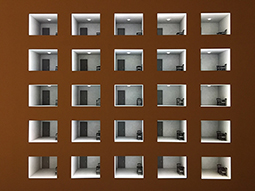 |
|
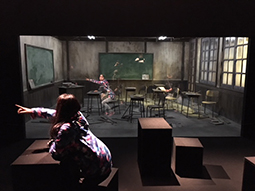 |
|
Leandro Erlich, The Room (Surveillance I) (2006/2017), 25-channel video installation, monitor. Collection of the artist; courtesy of Sean Kelly Gallery and Art Front Gallery. Photo by Lucy Birmingham |
|
Leandro Erlich, The Classroom (2017), wood, window, desk, chair, door, glass, light. Courtesy of Mori Art Museum. Photo by Lucy Birmingham |
Clearly, we are responsible for our future and its construction. But the genius of Erlich is his ability to invite us onto his "stage" to see differently, as never before, through objects well known in our daily lives: an elevator, a window, a building facade, a boat floating in water, a swimming pool. The experience is disruptive -- rebooting the way we look at our world, unlocking our imaginations and perhaps enabling us to build a future more responsibly.
Erlich's acclaimed The Swimming Pool has been rippling across the imagination of viewers since 1999, when at 26 he first displayed the installation during his artist's residency at the Museum of Fine Arts in Houston, Texas. Fame quickly followed when at 28 he was invited to represent his country, Argentina, in the 49th Venice Biennale. Now with a 25-year art practice behind him, his popularity has soared worldwide -- along with burgeoning ticket sales welcomed by numerous art institutions.
 |
|
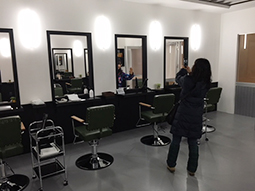 |
|
Leandro Erlich, The View (1997/2017), approx. 10 min. each (loop), 12-channel video installation, projector. Courtesy of Mori Art Museum. Photo by Lucy Birmingham |
|
Leandro Erlich, Hair Salon (2008/2017), wood, mirror, chair, aluminum sash, light. Courtesy of Mori Art Museum. Photo by Lucy Birmingham |
In Japan, Erlich is well known for The Swimming Pool commissioned by the 21st Century Museum of Contemporary Art, Kanazawa and on permanent display there since 2004. Two years later, Art Front Gallery Director Fram Kitazawa invited him to participate in the 2006 Echigo-Tsumari Art Triennale, where he created Tsumari's House. Since then, he has also built two permanent works in the same rural region: Tunnel in 2012 for the Echigo-Tsumari Satoyama Museum of Contemporary Art KINARE, and Lost Winter in 2017 for the Sansho House. For the Triennale this year (29 July - 17 September) he will be displaying yet another new artwork. Meanwhile, Art Front Gallery in Tokyo's Daikanyama district is hosting Erlich's Cosmic & Domestic exhibition until 25 February.
At the Mori show -- his biggest ever -- viewers can fully immerse themselves in Erlich's ubiquitous oeuvre. There are 44 interactive installations and photo-referential images. Eighty percent are being shown for the first time in Japan. (The Swimming Pool is displayed in photographs only.)
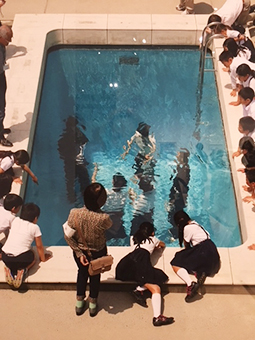 |
|
 |
|
Leandro Erlich, Documentation Photography of The Swimming Pool (2014), inkjet print. The Swimming Pool (2014), concrete, glass, water, 280 x 402 x 697 cm. Photo by Kioku Keizo; courtesy of 21st Century Museum of Contemporary Art, Kanazawa (referential image) |
|
Leandro Erlich, Changing Rooms (2008), panel, frame, mirror, stool, curtain, light, dimensions variable. Courtesy of Mori Art Museum. Photo by Lucy Birmingham |
Standouts include Building (Bâtiment in French), first produced in 2004 for the annual Parisian art festival Nuit Blanche held throughout the city for one night. Erlich says he created the installation in relation to the urban landscape and also to function as a gathering place. There, strangers can meet and interrupt the "norms and conventions of their ordinary lives," he explains. Viewers/participants have responded to the work with spontaneity, laughter and awe.
His three-dimensional The Cloud series is particularly interesting: cloud shapes created using white ceramic ink form the geographical shapes of France, Germany, Britain and Japan. The work is an illusionary play on mankind's tendency to add order and form where there is none -- in Erlich's example, dividing geographical terrain into nation-states. When considered long-term, these national divisions and borders always change -- like ephemeral clouds.
The Classroom is a new work, created especially for the Mori exhibition, that references Japan's declining birthrate and population. As with many of his pieces, Erlich has used glass to separate two spaces, creating a visual mix of what is real and what is not. Here, he shows a classroom in a closed and abandoned school. As viewers/participants enter a room, they appear like ghosts in the classroom on the other side. The experience not only conjures up childhood memories, but also sheds a light on the tens of thousands of shuttered elementary schools throughout Japan's countryside.
 |
|
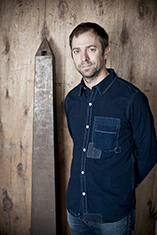 |
|
Leandro Erlich, Port of Reflections (2014), fiberglass, metal frame, movement system, wood and acrylic panel, dimensions variable. Installation view, Hanjin Shipping The Box Project 2014, National Museum of Modern and Contemporary Art, Korea, 2014. Courtesy of National Museum of Modern and Contemporary Art, Korea; Art Front Gallery; Galleria Continua |
|
Leandro Erlich (Portrait). Courtesy of Mori Art Museum. Photo by Alejandro Guyot |
When Erlich first produced The Room (Surveillance I) in 2006, the British government had just announced it had access to over two million surveillance cameras. This was one camera for every 14 people in the country. In Erlich's installation there are 25 cameras displaying the same room filmed from different angles. No one enters or exits the room, rendering the surveillance effort futile. Now, in 2018, with surveillance easily accomplished through the Internet, artificial intelligence (AI) and other resources, it's clearly not just futile but has crossed the border into invasion of privacy. The work remains deeply relevant, still inspiring viewers to imagine the repercussions of surveillance in our future world.
For Erlich, inspiration has come from a variety of sources. He often mentions the film directors Roman Polanski, Alfred Hitchcock, Luis Buñuel, David Lynch, and the French novelist Georges Perec (1936-82). He also credits his fellow countryman, the Argentinian short-story writer and poet Jorge Luis Borges (1899-1986), an influential figure in Spanish-language literature.
Interestingly, in Erlich's artistic practice, there appears to be little reference to his home country. And while it's now politically correct for artists not to identify with a nationality, religion or region, he is one of the few artists in the world who has managed to do this successfully. For most, their work inevitably reflects their cultural and social background. In contrast, Erlich's work is truly international -- with no illusion about that.
All images are shown by permission of the Mori Art Museum.
|
 |
 |
Lucy Birmingham
Lucy Birmingham is a long-time, Tokyo-based journalist, scriptwriter, author, and former photojournalist. She recently served two years as president of the Foreign Correspondents' Club of Japan. She has written regularly for TIME magazine and her articles have appeared in many publications, including the Wall Street Journal, Newsweek, Bloomberg News, and Architectural Digest. As an arts and culture writer her articles have appeared in publications including Artinfo.com, Artforum.com, and ARTnews. She is also a scriptwriter and narrator for NHK (Japan's public broadcaster) and has published several books including Strong in the Rain: Surviving Japan's Earthquake, Tsunami, and Fukushima Nuclear Disaster. lucybirmingham.com |
|
 |
|